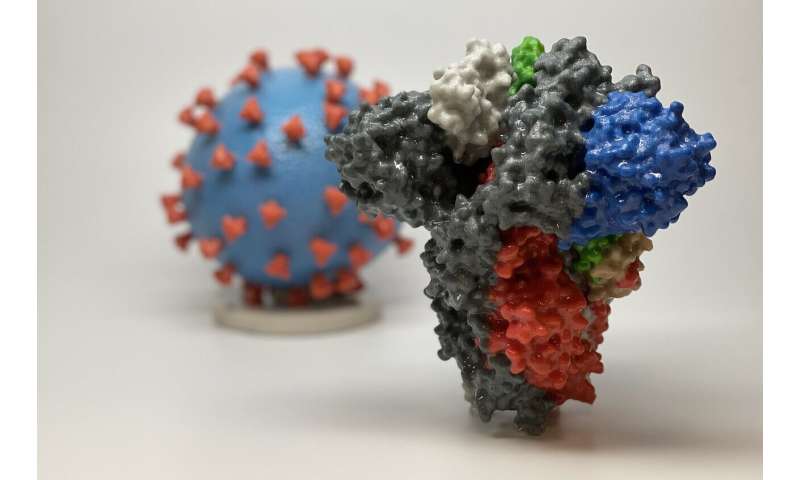


.
What makes SARS-CoV-2, the virus behind COVID-19, such a danger? A new study, led by Jose Ordovas-Montanes, Ph.D. at Boston Children’s Healthcare facility and Alex K. Shalek, Ph.D. at MIT, determines the likely cell types the infection contaminates. Suddenly, it also shows that a person of the body’s primary defenses against viral infections might actually assist the virus infect those very cells. Findings were published April 21 by the journal Cell
The peer-reviewed research study, released as a preprint, will help focus efforts to comprehend what SARS-COV-2 carries out in the body, why some people are more prone, and how finest to look for treatments, the researchers state.
Several research study designs
When news broke about a new coronavirus in China, Ordovas-Montanes and Shalek had already been studying different cell types from throughout the human respiratory system and intestinal tract. They also had actually gathered information from primates and mice.
In February, they started diving into these information.
” We began to take a look at cells from tissues such as the lining of the nasal cavity, the lungs, and gut, based upon reported symptoms and where the infection has actually been identified,” says Ordovas-Montanes. “We wanted to supply the best info possible throughout our whole spectrum of research designs.”
COVID-19- susceptible cells
Recent research had discovered that SARS-CoV-2– like the closely associated SARS-CoV that caused the SARS pandemic, utilizes a receptor called ACE2 to gain entry into human cells, aided by an enzyme called TMPRSS2. That led Ordovas-Montanes and Shalek and coworkers to ask a simple question: Which cells in respiratory and digestive tract tissue express both ACE2 and TMPRSS2?
To address this concern, the team turned to single-cell RNA sequencing, which identifies which of roughly 20,000 genes are “on” in specific cells. Those cells fall in 3 types: goblet cells in the nose that secrete mucus; lung cells understood as type II pneumocytes that help maintain the alveoli (the sacs where oxygen is taken in); and one type of so-called enterocytes that line the little intestine and are involved in nutrient absorption.
Sampling from non-human primates revealed a comparable pattern of prone cells.
” Numerous existing respiratory cell lines might not consist of the complete mix of cell types, and might miss out on the types that are relevant,” Ordovas-Montanes notes. “As soon as you understand which cells are infected, you can start to ask, ‘How do these cells work?’ ‘Is there anything within these cells that is vital for the infection’s life cycle?’ With more refined cellular models, we can carry out better screens to find what existing drugs target that biology, providing a stepping stone to go into mice or non-human primates.”
Interferon: Handy or hazardous?
But it was the research study’s second finding that the majority of intrigues the researchers. They discovered that the ACE2 gene, which encodes the receptor used by SARS-CoV-2 to go into human cells, is stimulated by interferon– among the body’s main defenses when it spots a virus. Interferon really turned the ACE2 gene on at greater levels, possibly offering the infection brand-new portals to get in.
” ACE2 is also vital in protecting individuals throughout different types of lung injury,” notes Ordovas-Montanes.
Interferons, in reality, are being tested as a treatment for COVID-19
” It might be that in some patients, since of the timing or the dosage, interferon can contain the virus, while in others, interferon promotes more infection,” states Ordovas-Montanes. “We wish to much better comprehend where the balance lies, and how we can keep an efficient antiviral response without producing more target cells for the infection to infect.”
ACE inhibitors and cytokine storms
The findings may also raise brand-new lines of questions around ACE inhibitors.
” ACE and ACE2 operate in the same path, however they actually have various biochemical residential or commercial properties,” Ordovas-Montanes warns. “It’s intricate biology, but it will be important to comprehend the impact of ACE inhibitors on individuals’s physiological response to the virus.”
It’s likewise prematurely to attempt to relate the study findings to the “cytokine storm,” a runaway inflammatory response that has been reported in really ill COVID-19 clients. Cytokines are a household of chemicals that rally the body’s immune responses to fight infections, and interferon belongs to the household.
” It might be that we’re seeing a cytokine storm since of a failure of interferon to restrict the virus to begin with, so the lungs start requiring more aid. That’s exactly what we’re attempting to comprehend today.”
Future directions
The group likewise wishes to explore what the infection is doing in the cells it targets, and to study tissue samples from kids and adults to comprehend why COVID-19 is typically less extreme in younger people. Research studies will continue at Boston Children’s with the support of Benjamin Raby, MD, Miles Per Hour, chief of pulmonary medication, Bruce Horwitz, MD, Ph.D., in emergency situation medicine, and Scott Snapper, MD, Ph.D., chief of gastroenterology.
Carly Ziegler, Samuel Allon, and Sarah Nyquist, of MIT and Harvard, and Ian Mbano of the Africa Health Research study Institute were co-first authors on the paper in Cell The study was done in cooperation with the Human Cell Atlas (HCA) Lung Biological Network group.
” This has been an extraordinary neighborhood effort– not just within Boston, but also with collaborators around the world who have all shared their unpublished information to try and make potentially appropriate info offered as rapidly as possible,” states Shalek, who was co-senior author on the paper with Ordovas-Montanes. “It’s inspiring to see how much can be achieved when everybody comes together to tackle an issue.”.
Citation:.
How SARS-CoV-2 enters breathing tissue– and how it might make use of among our defenses (2020, April 22).
obtained 22 April2020
from https://medicalxpress.com/news/2020-04- sars-cov-respiratory-tissueand-exploit-defenses. html.
This file is subject to copyright. Apart from any reasonable dealing for the purpose of personal study or research, no.
part may be recreated without the written permission. The content is attended to info purposes just.

